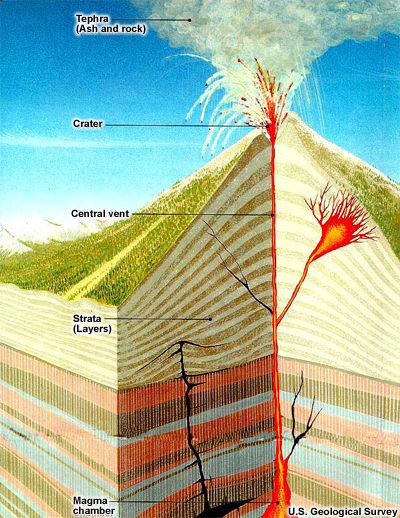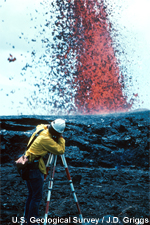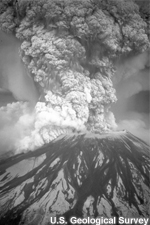Eruption Types
Volcanoes come in different shapes and sizes but share several common features.
- Each volcano has a shallow "plumbing system” that can include a magma chamber or a zone where magma can accumulate.
- The magma chamber is connected to the surface by a conduit system, simplified in the graphic below as a vertical pipe.
- The motion associated with volcanic activity can also create fractures connected to the central vent or the magma chamber. Such fractures can result in flank eruptions of magma, gases and ash.

A cross-section view of a typical volcano during an eruption. Starting at the bottom, magma rises through strata (rock layers) to the surface, following one or more conduits. While most magma rises to the top of the volcano and erupts through the central vent, other magma may follow diverging conduits and erupt on the flanks of the volcano. Some magma may never reach the surface, intruding laterally into the strata instead. The magma rises through more than one crack; some of the magma pushes up the strata layers while other magma moves to the top opening(s) of the volcano. The raised opening that emits magma is called the cone. The crack that reaches to the top of the cone is called the Central Vent. Along with the magma, the volcano emits a cloud of tephra (ash and large particles). (US Geological Survey)
The production of ash during a volcanic eruption is controlled by the characteristics of the erupting magma, including chemical composition, crystal content, temperature, dissolved gases, and also by interaction with water, especially groundwater.
Question
Can a volcano erupt without producing volcanic ash? (Choose the best answer.)
The correct answer is a) Yes.
In some cases, the amount of dissolved gasses and characteristics of the magma are such that no ash is produced. In these instances, magma with very low volatile content (dissolved water and gases) tends to erupt more quietly, producing little or no volcanic ash. The amount of volatile content contributes to the eruption style of volcanoes.
Depending on these characteristics and the rate of magma eruption, volcanoes display a marked range of eruption styles. For example, volcanic eruptions range from:

- Effusion of lava fountains and flows with very little ash erupted (such as Kilauea in Hawaii). Some of these non-explosive eruptions are extruded from fissures, can cover vast areas, and are the least dangerous type.

- Extremely explosive eruptions that inject large quantities of ash and gases high into the stratosphere (such as Mount Pinatubo). These explosive eruptions result from rapidly expanding gases within the rising magma. They cause widespread ash fall, pyroclastic flows, debris avalanches, landslides, and lahars.
Explosive eruptions are dependent upon the amount of dissolved gases in the magma and its viscosity:
- A low-viscosity magma (like Hawaiian eruptions) allows gases to readily escape to the surface, therefore reducing the probability of explosive release.
- Conversely, a high-viscosity magma (like that from Mount St. Helens) will retain the gases and increase the pressure. This increases the potential of explosive release.
